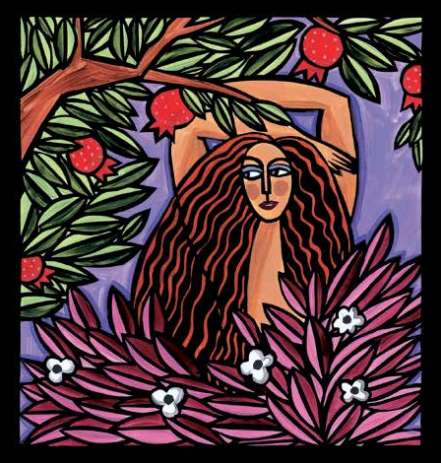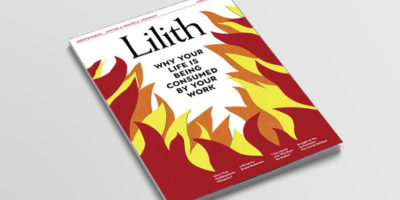
These New Jewish Holidays Brought to You By Feminism
Meeting Our Needs for Celebration and Mourning
I AM IN THE BUSINESS of narratives, and I teach how foundation stories (like those in the Bible) establish patterns that wear ruts in the cultural psyche, such as the pattern of the barren mother, whose desperation, longing, and sense of loss evolved from her biblical origins into the powerfully influential stereotypes of Jewish motherhood; or that of the youngest Jewish son, beloved of the favorite mother, foppish like Joseph, or controlled by his mother, like Jacob, which shaped the characterization of Jewish masculinity in the West, with dire consequences, for centuries. Or the many Bible stories in which the bedroom is the battlefield where men always lose, no matter how strong the hero, a myth of fatal female sexuality (think Yael, Delilah, or Judith) that has long justified its containment.
Jewish feminists have trained a gender lens on all of the influential texts of Judaism, adjusting what we look for and how we interpret everything from Talmud to Zohar to Kafka. Jewish feminism has changed the questions that sociologists pose of the Jewish community. Every field in the humanities and social sciences has been revised by the contributions of these scholars. These innovations were informed by, and went on to shape, every dimension of Jewish practice, from lifecycle and holiday ritual and ceremony to prayer, the arts, and popular culture.
Lilith magazine—a bridge between the academy and community and a megaphone for each—has been a critical instrument since 1976 in what has proven to be an immensely successful movement to expand, reimagine, and sometimes completely upend Jewish thought and practice, thanks in large part to the miraculous combination of the brilliant intelligence, perseverance, hard work, and graciousness of its editors.
By the 1990s Jewish feminist activism was becoming institutionalized. The Jewish Women’s Archive committed itself to recovering women’s history and created curricula; the Hadassah-Brandeis Institute supported Jewish feminist scholarship and publication; Kolot at the Reconstructionist Rabbinical College (RRC) created the Rosh Hodesh project for girls, and with Ma’yan at Manhattan’s JCC, ritualwell. org. Mayyim Hayyim, the Boston-area community mikveh, recuperated mikveh for feminist Jews. Ma’yan popularized the community feminist seder and supplemented the Haggadah. Project Kesher brought women’s studies and education to the Jews of the former Soviet Union. B’not Esh, a small but influential spiritual collective, had long been quietly setting a Jewish feminist agenda, and Keshet, the Jewish LGBTQ organization, later emerged with a comprehensive mission of inclusion. Time-honored women’s organizations such as Hadassah began to reinvent themselves.
A well-trafficked website, ritualwell.org harnessed the power of the internet to help feminists defrost the liturgy and democratize religion by disseminating innovation, and at RRC we revised the curriculum for rabbinical students in ways that would have an exponential impact as feminist-trained rabbis went on to lead congregations, Hillels, and other Jewish communal institutions.
Jewish feminism also changed the look of liberal Judaism. With the creativity invested in developing brit banot ceremonies for newborn daughters, the time-honored but tired brit ceremonies for newborn sons were revitalized and invested with contemporary relevance. Similarly, feminist seders contributed to more meaningful home seders, including such additions as rituals for Miriam’s Cup and the orange on the seder plate. Ritual garb was reimagined and tallitot and kippot became more colorful and multi-textured.
WAITING FOR MORE CHANGE
JEWISH FEMINIST SCHOLARS discovered folk practices that focused on girls’ and women’s lifecycle moments, noticed textual details that suggested possibilities for women’s communal practices, and infused Jewish holidays with contemporary relevance. Yet today, as in the past, it remains frustratingly difficult for these discoveries and innovations to become canonized, expected Jewish communal practice across denominations and around the globe. Some examples of failed recuperations include chag habanot; Judith as a Chanukah heroine (and the model of Judith’s relationship with her maid); techines (women’s folk prayer); the four days of mourning following the death of Bat Yiftach that seems to have been the origin of an annual women’s practice. (The timbrel, birth practices, and the use of Ta’anit Esther to fight for the rights of agunot or draw attention to the problem of human trafficking have had limited momentum.) A little more about two of these lost occasions:
Rabbi Jill Hammer, following Penina Adelman, discovered that on the Rosh Hodesh (the New Moon) of Chanukah, North African and Moroccan Jewish communities distinguished a holiday-within-the-holiday called chag habanot, the “Daughters’ Holiday.” Chanukah, uniquely, is a holiday that straddles two Hebrew months, so it contains a Rosh Hodesh—a new moon festival that had long been special to women. On the Rosh Hodesh during Chanukah, not only did girls receive special presents, but they were encouraged to use the occasion to end any quarrels that may have interfered with their relationships with one another. It is hard to imagine a practice that answers a need of today’s adolescent girls more immediately.
Another example: Where is the holiday of women’s mourning that is carefully explained in the Tanakh, in the Book of Judges? In one story, Jephthah foolishly vows that in exchange for a military victory, he will sacrifice the first living being whom he sees. Horribly, it turns out to be his beloved daughter, who greets him with her timbrel. But he postpones the necessary deed. Asked if she may leave with her women companions to “mourn her virginity,” in the text’s words: “‘You may go’, he said. And he let her go for two months. She and her friends went into the hills and wept because she would never marry. After the two months, she returned to her father, and he did to her as he had vowed. And she was a virgin. From this comes the Israelite tradition that each year the young women of Israel go out for four days to commemorate the daughter of Jephthah the Gileadite” (Judges 11:38-40). Indeed, the whole painful story seems to exist only to explain a four day women’s ritual of mourning, whether four consecutive days or perhaps the solstices and equinoxes, we cannot know. What we do know is that this biblically described women’s ritual is no more, despite the fact that we surely still have losses to mourn.
Like Jephthah’s daughter with her timbrel, Miriam led all of the Israelite women in celebration of God’s miracle after the parting of the Red Sea. The timbrel, or tambourine—another long-forgotten women’s ritual object—reminds us, too, of the midrashim (legends about Bible stories) that proclaim women’s faithful unwillingness to contribute to the making of the Golden Calf, or their life-affirming seductiveness after Pharaoh decreed death to baby boys. The midrash singles women out for their faith and optimism, and God gifts them with Rosh Hodesh, a mini-monthly Rosh Hashanah. Artist Betsy Teutsch led the way in reinventing tambourines for today’s Jewish women, and liberal Judaism tried to reestablish Rosh Hodesh for its own constituents. But these recuperations, too, have had relatively limited staying power to date.
Kabbalat Shabbat is a relatively new liturgical innovation that managed to have cultural stickiness. Maybe the Miriam’s Cup, which has found its way into more and more Hagaddot and Jewish bookstores, will also someday seem as if it had been ordained at Sinai. Feminism has made fast but not necessarily deep progress as many innovations and recuperations have not infiltrated Jewish life in its kishkes, beyond such tokenism in liturgical prayer as naming the Foremothers along with their male counterparts.
UPENDING TRADITIONS
I LIKE TO TEACH ABOUT the example of Lilith. In the Zohar, in Jewish mysticism, she is either a transmogrified version of, or a consort to, the devil Samael, the source of temptation and evil in the world with both seductive and monstrous manifestations. Adam’s first wife, this rebel, who prefers to be eternally exiled from human company rather than to live under the authority of Adam and God, had been for most of Jewish history a mythic figure of unequivocal evil. But just as Jewish feminists admired Vashti’s seemingly reasonable willingness to say no to the King, they also admired Lilith’s spunk, and wrote stories and poetry that reimagined Lilith as a maligned heroine. Judith Plaskow imagined a nascent friendship between Eve and Lilith that would leave both Adam and God wondering about what these two first women would accomplish together. In one of Enid Dame’s many Lilith poems, “Lilith’s Talent,” Lilith mothers energy and creativity and laments that men fearfully “insist on calling” the progeny they help her create “demons.”
Milton, in Paradise Lost, rationalizes midrashic intervention, with the explanation that he “justifies the ways of God to men.” Lilith magazine contributes a comparable project of changing the Jewish story, in reclamations and social change movements that seize and revise our existential narratives and engage in acts of discovery, recovery, and invention. Lilith is now undeniably a heroine.
These days, I cannot speak anywhere and ignore the fact that we are living at a dark moment, one that includes assaults on the value of the humanities and the threat of terrible compromise of funding for our life-changing work. Jewish studies seem to me more urgent than ever. Jews embrace wanderers: from the principle of welcoming the stranger echoed at every seder because we were strangers in the land of Egypt to Emma Lazarus’s words on the Statue of Liberty: “Give me your tired, your poor, your huddled masses yearning to breathe free, the wretched refuse of your teeming shore” to Abraham and Sarah, who are most honored for their hospitality; the midrash imagines that their desert tent had four open tent flaps, so that travelers could be welcomed no matter from which direction they came. The book of Esther warns about the dangers of Jewish life in the Diaspora, where a mercurial monarch can be manipulated by a greedy, intolerant, narcissistic advisor with genocidal impulses.
The Jewish mystical tradition emphasizes the human power to repair cosmic damage by observing the mitzvot, which include the relentless pursuit of fairness and justice. Jewish values emphasize chesed, gracious generosity, and caring for the poor, the widow, and anyone who has been left behind. The Book of Ruth celebrates the landowner Boaz, who munificently observed the law to leave the corners of his fields for the needy gleaners, and whose marriage to Ruth, the foreign woman who attached herself to the Jewish people, led to the baby from whom the Davidic line towards Messianic redemption would continue. Judaism asks us to see divine glory in the faces of humanity, in all of its diversity, and Jewish values emphasize compassion, so that when we are judged, we may have earned mercy for ourselves.
What we learn from Jewish feminism is the example of resistance and perseverance. The rhetorical power of midrash, changing the story, is a strategy of resistance. Rebellion occurs when we seize the power to name, and thereby invert power relations, just as we honor Lilith for her refusal to let Adam name her as a lesser human; or Vashti for resisting bullying and Esther for her clever persistence; or Miriam for gathering women in community to recognize and affirm the possibility of miracles. On a parallel track, from the revival of Rosh Hodesh, to the Simchat Bat, to new wedding rituals, no aspect of the lifecycle or holiday cycle has been untouched by Jewish feminism.
That said, women’s folk practices and other contributions, always present, fall in and out of Jewish communal awareness, not canonized or mainstreamed. Today more than ever, we need to persist in facing the challenge of returning to Sinai.
Lori Hope Lefkovitz holds the Ruderman Chair in Jewish Studies at Northeastern, where she directs the Humanities Center and the Jewish Studies Program and is a professor of English. Her books include In Scripture: The First Stories of Jewish Sexual Identities. This piece originated as a talk at a Brandeis University/Lilith symposium, “Looking Back, Looking Forward.”


